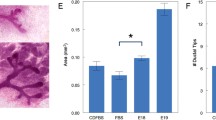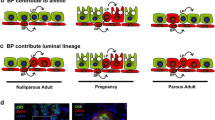Summary
Mammary gland epithelial cells from rats of different ages or with different reproductive histories vary in their proliferative properties and susceptibility to dimethylbenz(a)anthracene (DMBA) carcinogenesis in vivo. The present study was carried out to determine whether these differences are maintained under in vitro conditions. Primary cultures of mammary gland epithelial cells of young virgin, old virgin, and parous rats were treated with various doses of DMBA. Growth rates, DNA synthesis, and dose-response curves were determined; the toxicity of DMBA was measured by its effect on cell growth. Cell morphology was studied by transmission and scanning electron microscopy. Epithelial cells from the mammary gland of young virgin rats adapted rapidly to the culture conditions, behaving as if the cells were in the logarithmic phase of growth prior to plating. Mammary gland epithelial cells from old virgin and parous rats required a lag period prior to cell growth during which the proliferating cells adapted to the culture conditions. Cells from each group had comparable doubling times, and DNA synthesis peaked approximately 1 d after initiation of growth in culture. The numbers of proliferating cells decreased with increasing age and parity of the donor. Mammary gland epithelial cells of young virgin rats were more susceptible to both low and high doses of DMBA than those of old virgin and parous rats when the carcinogen was added either 24 h after plating or at the peak of DNA synthesis. These results indicate that age and parity influence the proliferative status of the cells and their susceptibility to DMBA in vitro, simulating in that way the in vivo situation.
Similar content being viewed by others
References
Mazzaleni, G. F. Rapporti di frequenza fra carcinoma mammario e gravidanza. Riv. Anat. Oncol. 17:243–260; 1960.
Wynder, E. L.; Bross, I. J.; Hirayama, T. A study of the epidemiology of cancer of the breast. Cancer 13:559–601; 1960.
MacMahon, B. Etiology of human breast cancer. J. Natl. Cancer Inst. 50:21–42; 1973.
Russo, J.; Saby, J.; Isenberg, W.; Russo, I. H. Pathogenesis of mammary carcinomas induced in rats by 7,12-dimethylbenz[a]anthracene. J. Natl. Cancer Inst. 59:435–445; 1977.
Huggins, C.; Briziarelli, G.; Sutton, H. Rapid induction of mammary carcinoma in the rat and the influence of hormones on the tumors. J. Exp. Med. 109:25–54; 1959.
Moon, R. C. Relationship between previous reproductive history and chemically induced mammary cancer in rats. Int. J. Cancer 4:312–317; 1969.
Russo, J.; Russo, I. H. DNA labeling index and structure of the rat mammary gland as determinants of its susceptibility to carcinogenesis. J. Natl. Cancer Inst. 61:1451–1459; 1978.
Russo, J.; Russo, I. H. Influence of differentiation and cell kinetics on the susceptibility of the rat mammary gland to carcinogenesis. Cancer Res. 40:2677–2687; 1980.
Cohen, L. A.; Tsuang, J.; Chang, P. C. Characterization of rat normal mammary epithelial cells and dimethylbenz[a]anthracene-induced mammary adenocarcinoma cells grown in monolayer culture. In Vitro 10:51–62; 1974.
Rivera, E. M.; Bern, H. A. Influence of insulin on maintenance and secretory stimulation of mouse mammary tissues by hormones in organ cultures. Endocrinology 69:340–353; 1961.
Mollenhauer, D. M. Plastic embedding mixtures for use in electron microscopy. Stain Technol. 39: 111–114; 1964.
Lowry, O. H.; Rosebrough, N. J.; Farr, A. W.; Randall, R. J. Protein measurement with the folin phenol reagent. J. Biol. Chem. 193: 265–275; 1951.
Burton, K. A study of the conditions and mechanism of the diphenylamine reaction for the colorimetric estimation of deoxyribonucleic acid. Biochem. M. 62:315–323; 1956.
Russo, J.; Furmanski, P.; Bradley, R.; Wells, P.; Rich, M. A. Differentiation of normal human mammary epithelial cells in culture: an ultrastructural study. Am. J. Anat. 145:57–78; 1976.
Russo, I. H.; Ireland, M.; Isenberg, W.; Russo, J. Ultrastructural description of three different epithelial cell types in rat mammary gland. Proc. Electron Microscopy Soc. Am. 34:146–147; 1976.
Hayflick, L. The limited in vitro lifetime of human diploid cell stains. Exp. Cell Res. 37:614–635; 1965.
Martin, G. M.; Sprague, C. A.; Epstein, C. J. Replicative life span of cultivated human cells. Effect of donor's age, tissue and genotype. Lab. Invest. 23:86–92; 1970.
Goldstein, S.; Littlefield, J. N.; Saeldner, J. S. Diabetes mellitus and aging diminished plating efficiency of cultured human fibroblasts. Proc. Natl. Acad. Sci. USA 64:155–160; 1969.
Hayflick, L.; Moorhead, P. S. The serial cultivation of human diploid cell strains. Exp. Cell Res. 25:585–621; 1961.
Schneider, E. L.; Mitsui, Y. The relationship between in vitro cellular aging and in vivo human age. Proc. Natl. Acad. Sci. USA 73:3584–3588; 1976.
Voyles, B. A.; McGrath, C. M. Differential response of malignant BALB/c mammary epithelial cells to the multiplication-stimulating activity of insulin. J. Natl. Cancer Inst. 62: 597–604; 1979.
Bowman, P. D.; Meek, R. L.; Daniel, C. W. Aging of human fibroblasts in vitro; correlations between DNA synthetic ability and cell size. Exp. Cell Res. 93:184–190; 1975.
Tay, L. K.; Russo, J. Binding of 7,12-dimethylbenz[a]anthracene (DMBA) to DNA and subsequent induction of DNA excision repair in rat mammary epithelial cells in vitro. Proc. Am. Assoc. Cancer Res. 21:272a; 1980.
Russo, J.; Tay, L. K.; Wilgus, G. 7,12-Dimethylbenz[a]anthracene (DMBA) on rat mammary epithelial cells in culture. Fed. Proc. 38(3):1249; 1979.
Janss, D. H.; Moon, R. E.; Irving C. E. The binding of 7,12-dimethylbenz(a)anthracene to mammary parenchyma DNA and protein in vivo. Cancer Res. 32:254–258; 1972.
Marquardt, H.; Sternberg S. S.; Phillips F. S. 7,12-Dimethylbenz(a)anthracene and hepatic neoplasia in regenerating rat liver. Chem. Biol. Interact. 2:401–403; 1970.
Prodi, G.; Rocchi, P.; Grilli, S. Binding of 7,12-dimethylbenz[a]anthracene and benzo(a)pyrene to nucleic acids and proteins of organs in rats. Cancer Res. 30:1020–1023; 1970.
Tominaga, T.; Dao, T. L.; Libby, P. R. Effects of 7,12-dimethylbenz[a]anthracene on RNA polymerase in isolated mammary gland cell nuclei. Proc. Soc. Exp. Biol. Med. 136:694–697; 1971.
Pound, A. W. Carcinogenesis and cell proliferation. New Zealand Med. J. 67:88–99; 1968.
Shunkin, M. B.; Gruenstein, M.; Thatcher, D. Tritiated thymidine labeling of cells in rats following exposure to 7,12-dimethylbenz[a]anthracene. Cancer Res. 27:1494–1495; 1967.
Marquardt, H.; Bendick, A.; Philips, F. S.; Hoffman, D. Binding of [G-3H]7,12-dimethylbenz[a]anthracene to DNA of normal and of rapidly dividing hepatic cells of rats. Chem. Biol. Interact. 3:1–11; 1971.
Tominaga, T.; Libby, P. R.; Dao, T. L. An early effect of 7,12-dimethylbenz[a]anthracene on rat mammary gland DNA synthesis. Cancer Res. 30: 118–122; 1970.
Tominaga, T.; Libby, P. R.; Dao, T. L. An early effect of 7,12-dimethylbenz[a]anthracene on rat mammary gland DNA synthesis. Cancer Res. 30: 118–122; 1970.
Shunkin, M. B.; Gruenstein, M.; Thatcher, D. Tritiated thymidine labeling of cells in rats following exposure to 7,12-dimethylbenz[a]anthracene. Cancer Res. 27:1494–1495; 1967.
Russo, J.; Isenberg, W.; Ireland, M.; Russo, I. H. Ultrastructural changes in the mammary epithelial cell population during neoplastic development induced by a chemical carcinogen. Proc. Electron Microscopy Soc. Am. 34:250–251; 1976.
Author information
Authors and Affiliations
Additional information
Supported by Public Health Service Grants CA-23539 and CA-27026 from the National Cancer Institute and by an Institutional grant from the United Foundation of Greater Detroit.
Rights and permissions
About this article
Cite this article
Russo, J., Wilgus, G., Tait, L. et al. Influence of age and parity on the susceptibility of rat mammary gland epithelial cells in primary cultures to 7,12-dimethylbenz(a) anthracene. In Vitro 17, 877–884 (1981). https://doi.org/10.1007/BF02618283
Received:
Accepted:
Issue Date:
DOI: https://doi.org/10.1007/BF02618283




